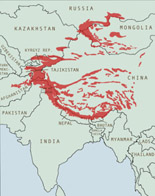I’ve become very interested in the Altai region in Russia recently because it’s snow leopard habitat and it’s likely I’ll be there this July. I’ve been trying to find the word the local people use for snow leopard and got an email from Jennifer Castner, the Director of the Altai Project.
But first, where is the Altai you might ask, as I did when I first heard about it. Well, it’s the unique and diverse mountain region of southern Siberia. And parts of the Altai have been declared a natural UNESCO World Heritage site for their importance in the preservation of endangered mammals, such as snow leopard, the Altai argali (a wild sheep) and the Siberian Ibex (wild goat). There are also some very ancient archaeological remains.
There’s a lot of pressures on this spectacular area, from gas pipelines to inappropriate development and underemployment of many of the local population. The Altai Project (based in California) is a small organisation working to ‘strengthen communities and protect nature in the Altai’. They’re working with local people and supporters from all over the world to protect the natural and cultural heritage and ways of life in the face of these challenges.
One of the goals of The Altai Project is nature conservation, which includes endangered wildlife like the snow leopard. And like most snow leopard habitats, there is very little hard data on how many cats remain and the best way to support them in that region.
Jennifer is an expert on this remote part of the world. She’s lived and studied in Moscow and lived and worked in Kiev and is fluent in Russian. She’s travelled extensively in Siberia and the Russian Far East and Ukraine.
Here’s her explanation for the terms for snow leopard used by various peoples in this part of the world.
Jennifer – “I noticed (on the Saving Snow Leopard’s Blog) that you’ve been trying to figure out the term for snow leopard in Russian, and I’ve been rather idly wondering about the exact etymology of the terms I know.  In the Altaian range of their habitat, they seem to refer to them mostly as “(snezhny) bars”, but also as “irbis.”
In the Altaian range of their habitat, they seem to refer to them mostly as “(snezhny) bars”, but also as “irbis.”
I hunted around a bit online to better understand the differences. Neither word is actually Russian in origin, which I knew. ‘Snezhny’ is a Russian adjective means ‘snowy’. That’s easy.
‘Bars’ seems to come to Russian from Iranian/Persian (and possibly further back from a Turkic language, depending on where you look. It seems to refer to any big cat, but generally is used for ‘snow leopard’ and is in common use across Russia. (The Amur leopard is called a ‘leopard’ in Russian. ‘Tigr’ for tiger.)
‘Irbis” is definitely a Turkic word for snow leopard or just panther/big cat. It’s the term used in the Altaian language and probably some of the other indigenous (Turkic) peoples living in historic snow leopard habitat. I think it’s more localized in use, but still recognizable to many people who know their wildlife.”
Thanks Jennifer. ‘Snezhny’ for snow is good to know, although I think in July there won’t be too much of that when I go, but ‘Bars’ is a useful word in any-one’s language!







{ 0 comments… add one }